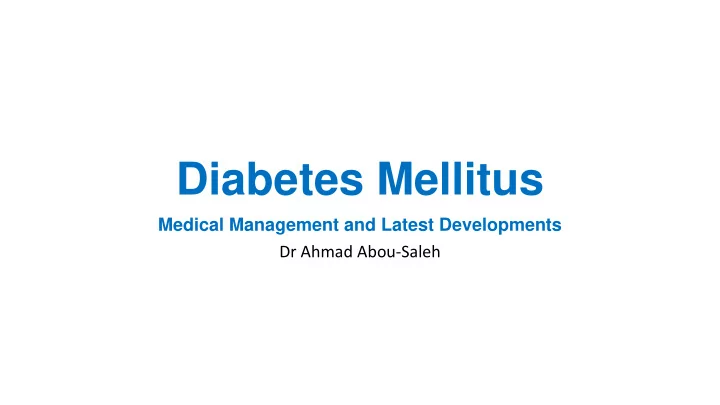

Diabetes Mellitus Medical Management and Latest Developments Dr Ahmad Abou-Saleh
What is Diabetes Mellitus? A disease characterised by a state of chronic elevation of blood glucose levels due to: - The body’s inability to produce insulin (insulin deficiency) And/Or - The body’s inability to respond to insulin (insulin resistance)
United Kingdom • 6 – 8% of UK Population is Diabetic • Approximately half a million undiagnosed Diabetics in the UK at any one time • 5 Million Diabetics in UK by 2025 • 10% of NHS Budget is spent on Diabetes care (~£10 Billion)
Type 1 Diabetes Mellitus • A disorder of the immune system where the body’s own ability to produce insulin is destroyed (nearly 100%) • Immune system wrongly target and destroy β -cells in the Pancreas • This can only be managed by immediately starting insulin therapy
Type 2 Diabetes Mellitus • 95% of all Diabetics are Type 2 • Combination of insulin deficiency (though not as much as Type 1 Diabetes Mellitus) and insulin resistance • Associated with Obesity, Hypertension and Hypercholesteraemia • Managed by a combination of diet, oral medications and injectable therapies (e.g. insulin)
Diabetic Complications Eye Disease Kidney Disease Heart Disease Cerebrovascular Disease Nerve Disease Peripheral Vascular Disease Foot Disease
Some of the potential outcomes of Diabetes! Cataracts Stroke Glaucoma Sensory Ataxia Retinopathy Painful Peripheral Neuropathy Blindness Mononeuritis Multiplex End-Stage Renal Failure Lumbosacral Plexopathy Dialysis Muscle Infarction Kidney Transplant Intermittent Claudication Heart Attack Acute Ischaemia and Necrosis Heart Failure Foot Ulceration Arrhythmias Toe Amputation Mini-Stroke Major Limb Amputation
Diabetic Foot Disease • Definition: Localised injury to the skin and/or underlying tissue (below the ankle) in a person with Diabetes 10% of all Diabetics will be diagnosed with a foot ulcer in their lifetime 50% will die within 5 years of developing a diabetic foot ulcer 70% will die within 5 years of having an amputation • Diabetes is the most common cause of non-traumatic limb amputation
Risk Factors for Diabetic Foot Disease • Neuropathy • Peripheral ischaemia • Swelling • Skin breakdown • Infection • Deformity • Callus
Treatment for Diabetes • Type 1 Diabetes Mellitus Multiple daily insulin injections Diet and Exercise • Type 2 Diabetes Mellitus Diet, exercise and weight loss Oral and/or injectable anti-diabetic medications (including insulin) Treat Hypertension and Hypercholesteraemia
Aims of Treatment • Prevent onset of complications • Slow the progression or cause reversal of existing complications • Prevent extremes of blood glucose levels (hyperglycaemia, hypoglycaemia) • Manage other risk factors e.g. Hypertension, Hypercholesteraemia
NICE Guidance on Type 2 Diabetes Mellitus
Treatment for Diabetes – Oral Medication • Biguanides – Metformin – Improve insulin sensitivity • Sulphonylureas – Gliclazide – Enhance insulin secretion • Thiazolidinediones – Pioglitazone – Improve insulin sensitivity • DPP4-inhibitors – Sitagliptin – Enhance effect of beneficial gut hormones • GLP-1 Analogues – Liraglutide (injection) – Synthetic beneficial gut hormone • SGLT2 inhibitors – Empagliflozin – Enhance excretion of glucose into urine
Diabetes and Insulin how far have we come?
Glucose lowering agents types of insulin available • Mealtime insulins • unmodified human • soluble • regular • rapid-acting analogues • Basal insulin • NPH insulin • protamine complex • long-acting analogues • Insulin mixes • soluble + NPH • rapid acting analogues + NPH
Glucose lowering agents possible insulin regimens • Type 1 Diabetes Mellitus • Fast-acting insulin with meals and 1- 2 basal insulin injections – optimal • Twice daily mix insulin • Type 2 Diabetes Mellitus • Once – Twice daily basal insulin • Twice daily mix insulin • Fast-acting insulin with meals and 1- 2 basal insulin injections
Monitoring Diabetes • Daily self-monitoring with use of blood glucose meters • Glycosylated Haemoglobin (HbA1c): Spot blood test providing information on average blood glucose over last 2 – 3 months
Updates in Type 2 Diabetes Mellitus
Personalised Care
New Glucose Lowering Agents • GLP-1 Analogues (injection): Synthetic gut hormone which works to reduce weight as well as blood glucose • SGLT2 inhibitors: Stimulates the kidney to allow more glucose to be removed in the urine – also helping to reduce weight alongside blood glucose
GLP-1 Analogue: Liraglutide injections
SGLT2 Inhibitor: Empagliflozin
SGLT2 Inhibitor: Canagliflozin
Diabetes reversal after <6 months low calorie diet • Special formula diet (approximately 820 kcal/day) • Nearly 50% had average blood glucose below the diabetic range (in “remission”) versus 4% through conventional measures • Progressively greater odds of successful remission of Diabetes with a higher amount of weight loss
Updates in Type 1 Diabetes Mellitus
Peptide Vaccine for newly Diagnosed Type 1 Diabetes Mellitus • Similar principles to vaccines for infections! • Newly diagnosed diabetics given subcutaneous injections every 2 – 4 weeks for 6 months • Preserves insulin production and better diabetic control (and lower insulin doses) in treatment group
Closed- Loop System “Artificial Pancreas”
Benefits • Improved diabetic control (glucose variability and average glucose values • Reduced amount of time patients spent with low blood glucose values (hypoglycaemia) • Automatic suspension of insulin delivery via pump when blood glucose drops too low
Glucose Monitoring now available on the NHS
Islet Cell Transplantation
Summary Diabetes caused by insulin deficiency and/or resistance Rising numbers UK and worldwide Managed by lifestyle modification, oral and injectable therapies Various developments – ongoing!
Recommend
More recommend